Evaluating Nestle's Recruitment, Selection, and Training Methods
VerifiedAdded on 2021/02/18
|35
|5921
|18
Project
AI Summary
This project analyzes Nestle's recruitment and training strategies to meet international requirements. It begins with an introduction to recruitment and selection, emphasizing the importance of effective HR practices for multinational companies. The project outlines aims, objectives, and research questions, followed by a literature review. It details project management aspects, including cost analysis, scope definition, timeframes, risk assessment, and resource allocation. A work breakdown structure and Gantt chart are presented to illustrate the project's timeline and stages. The research methodology employs qualitative methods for data collection and analysis. The project includes recommendations and conclusions based on the research findings, reflecting on the value of the research and its impact on learning and performance. The project incorporates a questionnaire and a log book in the appendix.
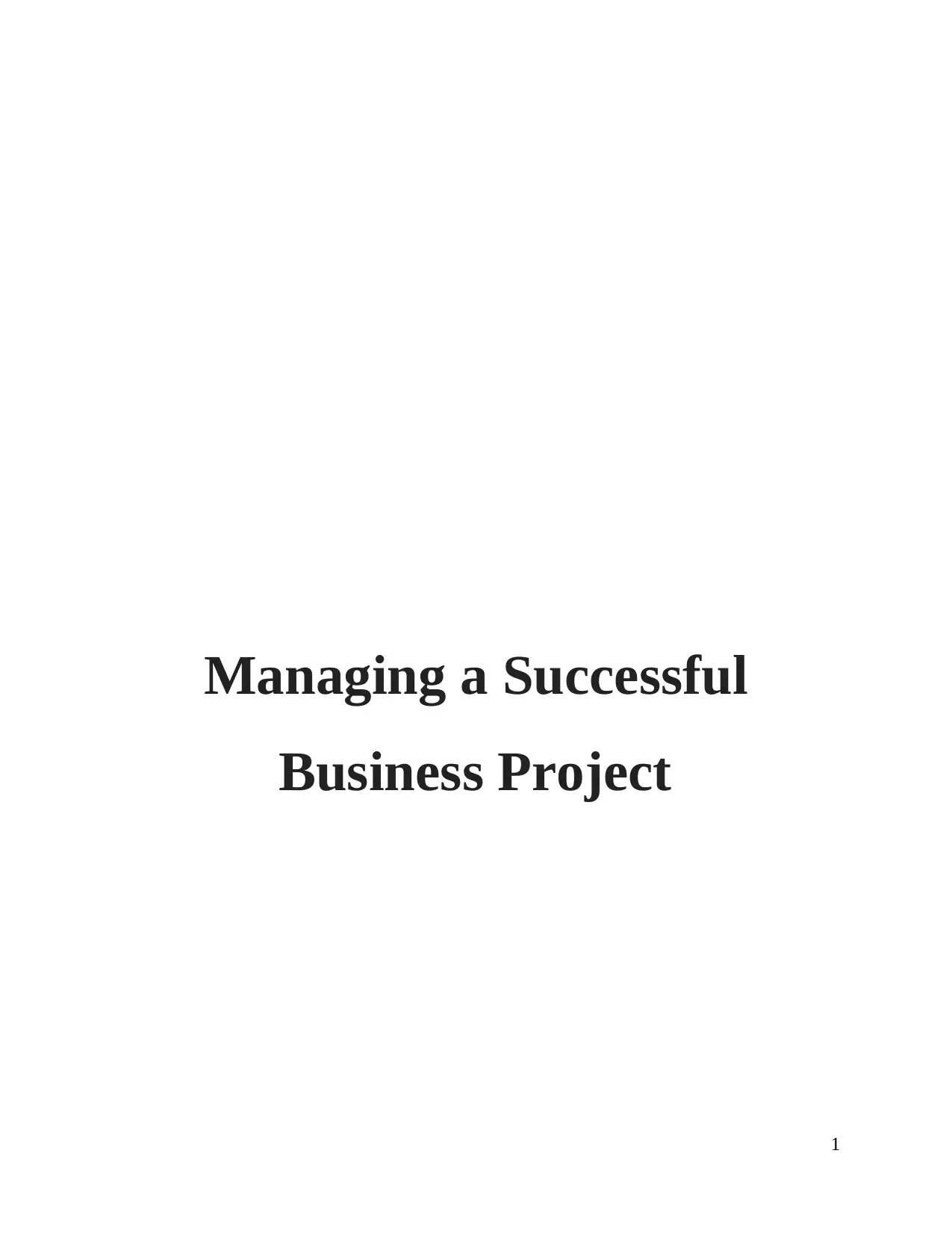
Managing a Successful
Business Project
1
Business Project
1
Paraphrase This Document
Need a fresh take? Get an instant paraphrase of this document with our AI Paraphraser
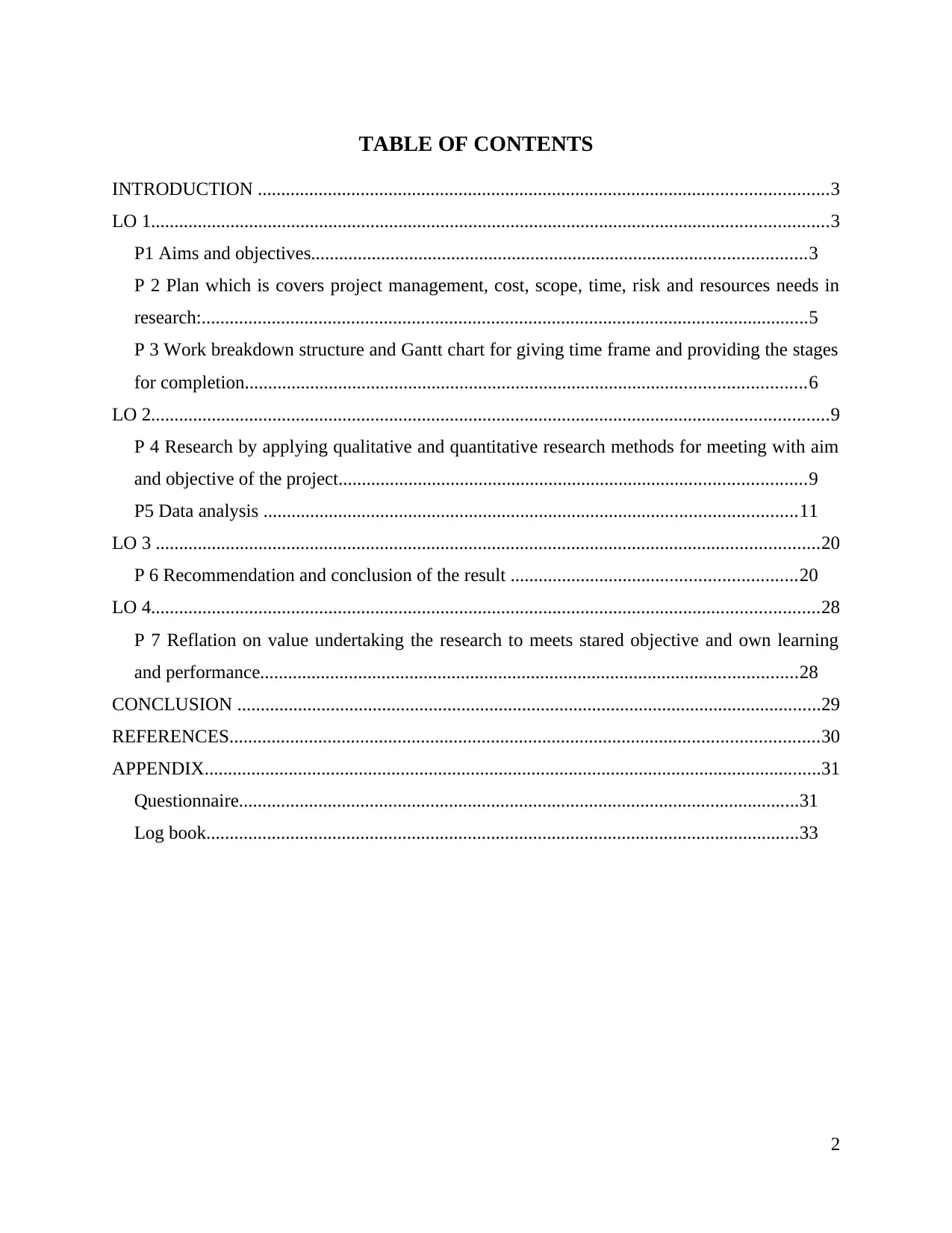
TABLE OF CONTENTS
INTRODUCTION ..........................................................................................................................3
LO 1.................................................................................................................................................3
P1 Aims and objectives..........................................................................................................3
P 2 Plan which is covers project management, cost, scope, time, risk and resources needs in
research:..................................................................................................................................5
P 3 Work breakdown structure and Gantt chart for giving time frame and providing the stages
for completion........................................................................................................................6
LO 2.................................................................................................................................................9
P 4 Research by applying qualitative and quantitative research methods for meeting with aim
and objective of the project....................................................................................................9
P5 Data analysis ..................................................................................................................11
LO 3 ..............................................................................................................................................20
P 6 Recommendation and conclusion of the result .............................................................20
LO 4...............................................................................................................................................28
P 7 Reflation on value undertaking the research to meets stared objective and own learning
and performance...................................................................................................................28
CONCLUSION .............................................................................................................................29
REFERENCES..............................................................................................................................30
APPENDIX....................................................................................................................................31
Questionnaire........................................................................................................................31
Log book...............................................................................................................................33
2
INTRODUCTION ..........................................................................................................................3
LO 1.................................................................................................................................................3
P1 Aims and objectives..........................................................................................................3
P 2 Plan which is covers project management, cost, scope, time, risk and resources needs in
research:..................................................................................................................................5
P 3 Work breakdown structure and Gantt chart for giving time frame and providing the stages
for completion........................................................................................................................6
LO 2.................................................................................................................................................9
P 4 Research by applying qualitative and quantitative research methods for meeting with aim
and objective of the project....................................................................................................9
P5 Data analysis ..................................................................................................................11
LO 3 ..............................................................................................................................................20
P 6 Recommendation and conclusion of the result .............................................................20
LO 4...............................................................................................................................................28
P 7 Reflation on value undertaking the research to meets stared objective and own learning
and performance...................................................................................................................28
CONCLUSION .............................................................................................................................29
REFERENCES..............................................................................................................................30
APPENDIX....................................................................................................................................31
Questionnaire........................................................................................................................31
Log book...............................................................................................................................33
2
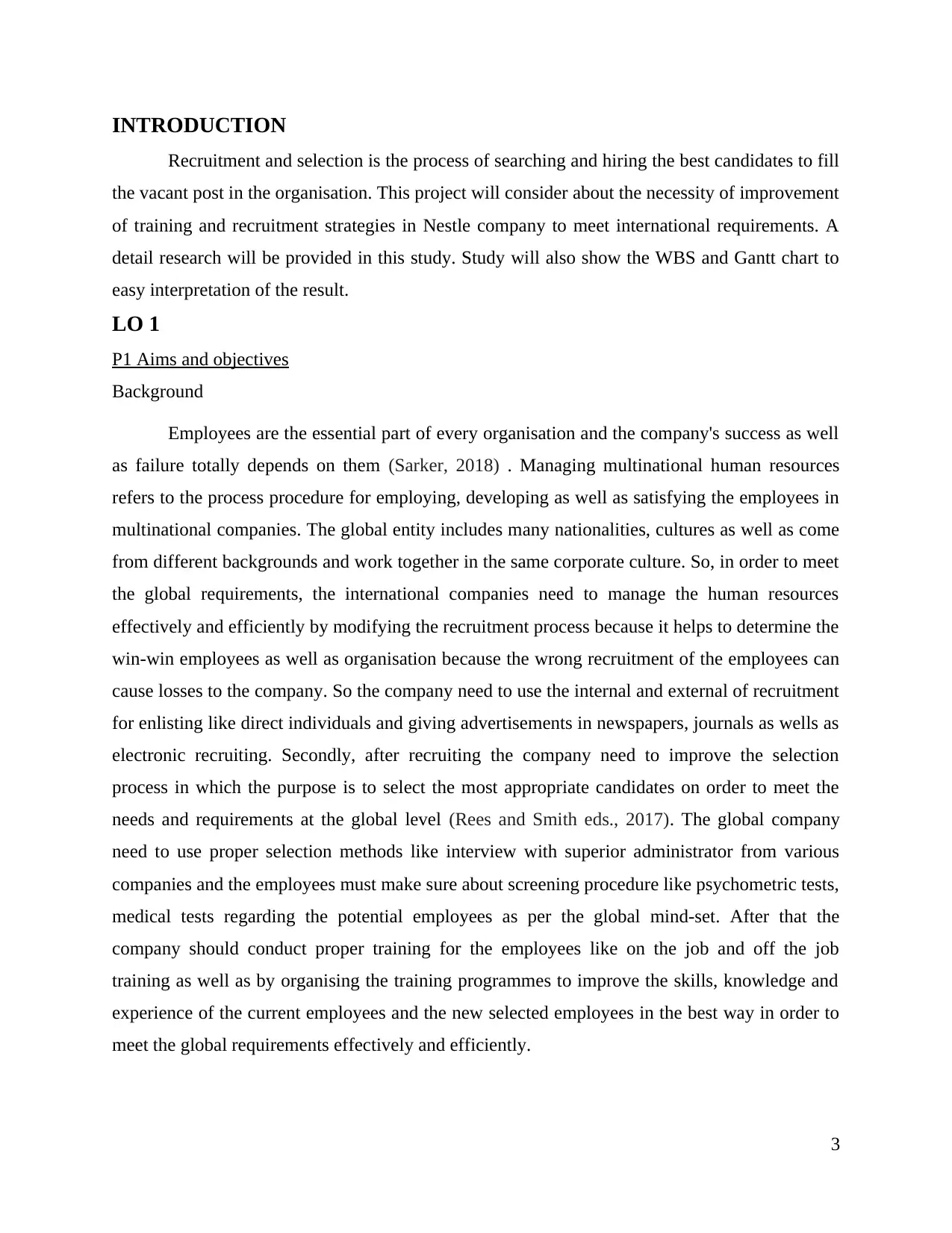
INTRODUCTION
Recruitment and selection is the process of searching and hiring the best candidates to fill
the vacant post in the organisation. This project will consider about the necessity of improvement
of training and recruitment strategies in Nestle company to meet international requirements. A
detail research will be provided in this study. Study will also show the WBS and Gantt chart to
easy interpretation of the result.
LO 1
P1 Aims and objectives
Background
Employees are the essential part of every organisation and the company's success as well
as failure totally depends on them (Sarker, 2018) . Managing multinational human resources
refers to the process procedure for employing, developing as well as satisfying the employees in
multinational companies. The global entity includes many nationalities, cultures as well as come
from different backgrounds and work together in the same corporate culture. So, in order to meet
the global requirements, the international companies need to manage the human resources
effectively and efficiently by modifying the recruitment process because it helps to determine the
win-win employees as well as organisation because the wrong recruitment of the employees can
cause losses to the company. So the company need to use the internal and external of recruitment
for enlisting like direct individuals and giving advertisements in newspapers, journals as wells as
electronic recruiting. Secondly, after recruiting the company need to improve the selection
process in which the purpose is to select the most appropriate candidates on order to meet the
needs and requirements at the global level (Rees and Smith eds., 2017). The global company
need to use proper selection methods like interview with superior administrator from various
companies and the employees must make sure about screening procedure like psychometric tests,
medical tests regarding the potential employees as per the global mind-set. After that the
company should conduct proper training for the employees like on the job and off the job
training as well as by organising the training programmes to improve the skills, knowledge and
experience of the current employees and the new selected employees in the best way in order to
meet the global requirements effectively and efficiently.
3
Recruitment and selection is the process of searching and hiring the best candidates to fill
the vacant post in the organisation. This project will consider about the necessity of improvement
of training and recruitment strategies in Nestle company to meet international requirements. A
detail research will be provided in this study. Study will also show the WBS and Gantt chart to
easy interpretation of the result.
LO 1
P1 Aims and objectives
Background
Employees are the essential part of every organisation and the company's success as well
as failure totally depends on them (Sarker, 2018) . Managing multinational human resources
refers to the process procedure for employing, developing as well as satisfying the employees in
multinational companies. The global entity includes many nationalities, cultures as well as come
from different backgrounds and work together in the same corporate culture. So, in order to meet
the global requirements, the international companies need to manage the human resources
effectively and efficiently by modifying the recruitment process because it helps to determine the
win-win employees as well as organisation because the wrong recruitment of the employees can
cause losses to the company. So the company need to use the internal and external of recruitment
for enlisting like direct individuals and giving advertisements in newspapers, journals as wells as
electronic recruiting. Secondly, after recruiting the company need to improve the selection
process in which the purpose is to select the most appropriate candidates on order to meet the
needs and requirements at the global level (Rees and Smith eds., 2017). The global company
need to use proper selection methods like interview with superior administrator from various
companies and the employees must make sure about screening procedure like psychometric tests,
medical tests regarding the potential employees as per the global mind-set. After that the
company should conduct proper training for the employees like on the job and off the job
training as well as by organising the training programmes to improve the skills, knowledge and
experience of the current employees and the new selected employees in the best way in order to
meet the global requirements effectively and efficiently.
3
⊘ This is a preview!⊘
Do you want full access?
Subscribe today to unlock all pages.

Trusted by 1+ million students worldwide
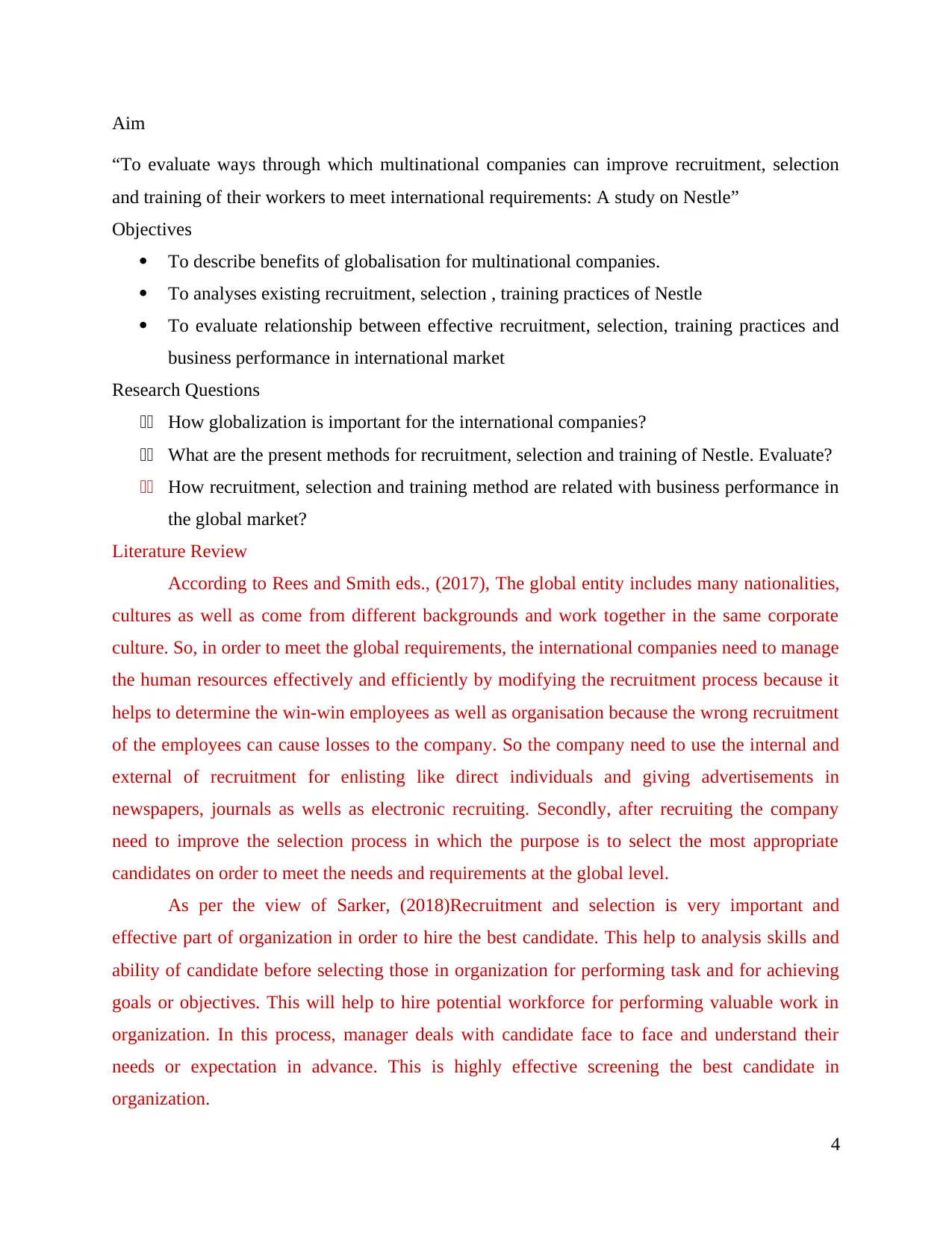
Aim
“To evaluate ways through which multinational companies can improve recruitment, selection
and training of their workers to meet international requirements: A study on Nestle”
Objectives
To describe benefits of globalisation for multinational companies.
To analyses existing recruitment, selection , training practices of Nestle
To evaluate relationship between effective recruitment, selection, training practices and
business performance in international market
Research Questions
11 How globalization is important for the international companies?
11 What are the present methods for recruitment, selection and training of Nestle. Evaluate?
11 How recruitment, selection and training method are related with business performance in
the global market?
Literature Review
According to Rees and Smith eds., (2017), The global entity includes many nationalities,
cultures as well as come from different backgrounds and work together in the same corporate
culture. So, in order to meet the global requirements, the international companies need to manage
the human resources effectively and efficiently by modifying the recruitment process because it
helps to determine the win-win employees as well as organisation because the wrong recruitment
of the employees can cause losses to the company. So the company need to use the internal and
external of recruitment for enlisting like direct individuals and giving advertisements in
newspapers, journals as wells as electronic recruiting. Secondly, after recruiting the company
need to improve the selection process in which the purpose is to select the most appropriate
candidates on order to meet the needs and requirements at the global level.
As per the view of Sarker, (2018)Recruitment and selection is very important and
effective part of organization in order to hire the best candidate. This help to analysis skills and
ability of candidate before selecting those in organization for performing task and for achieving
goals or objectives. This will help to hire potential workforce for performing valuable work in
organization. In this process, manager deals with candidate face to face and understand their
needs or expectation in advance. This is highly effective screening the best candidate in
organization.
4
“To evaluate ways through which multinational companies can improve recruitment, selection
and training of their workers to meet international requirements: A study on Nestle”
Objectives
To describe benefits of globalisation for multinational companies.
To analyses existing recruitment, selection , training practices of Nestle
To evaluate relationship between effective recruitment, selection, training practices and
business performance in international market
Research Questions
11 How globalization is important for the international companies?
11 What are the present methods for recruitment, selection and training of Nestle. Evaluate?
11 How recruitment, selection and training method are related with business performance in
the global market?
Literature Review
According to Rees and Smith eds., (2017), The global entity includes many nationalities,
cultures as well as come from different backgrounds and work together in the same corporate
culture. So, in order to meet the global requirements, the international companies need to manage
the human resources effectively and efficiently by modifying the recruitment process because it
helps to determine the win-win employees as well as organisation because the wrong recruitment
of the employees can cause losses to the company. So the company need to use the internal and
external of recruitment for enlisting like direct individuals and giving advertisements in
newspapers, journals as wells as electronic recruiting. Secondly, after recruiting the company
need to improve the selection process in which the purpose is to select the most appropriate
candidates on order to meet the needs and requirements at the global level.
As per the view of Sarker, (2018)Recruitment and selection is very important and
effective part of organization in order to hire the best candidate. This help to analysis skills and
ability of candidate before selecting those in organization for performing task and for achieving
goals or objectives. This will help to hire potential workforce for performing valuable work in
organization. In this process, manager deals with candidate face to face and understand their
needs or expectation in advance. This is highly effective screening the best candidate in
organization.
4
Paraphrase This Document
Need a fresh take? Get an instant paraphrase of this document with our AI Paraphraser
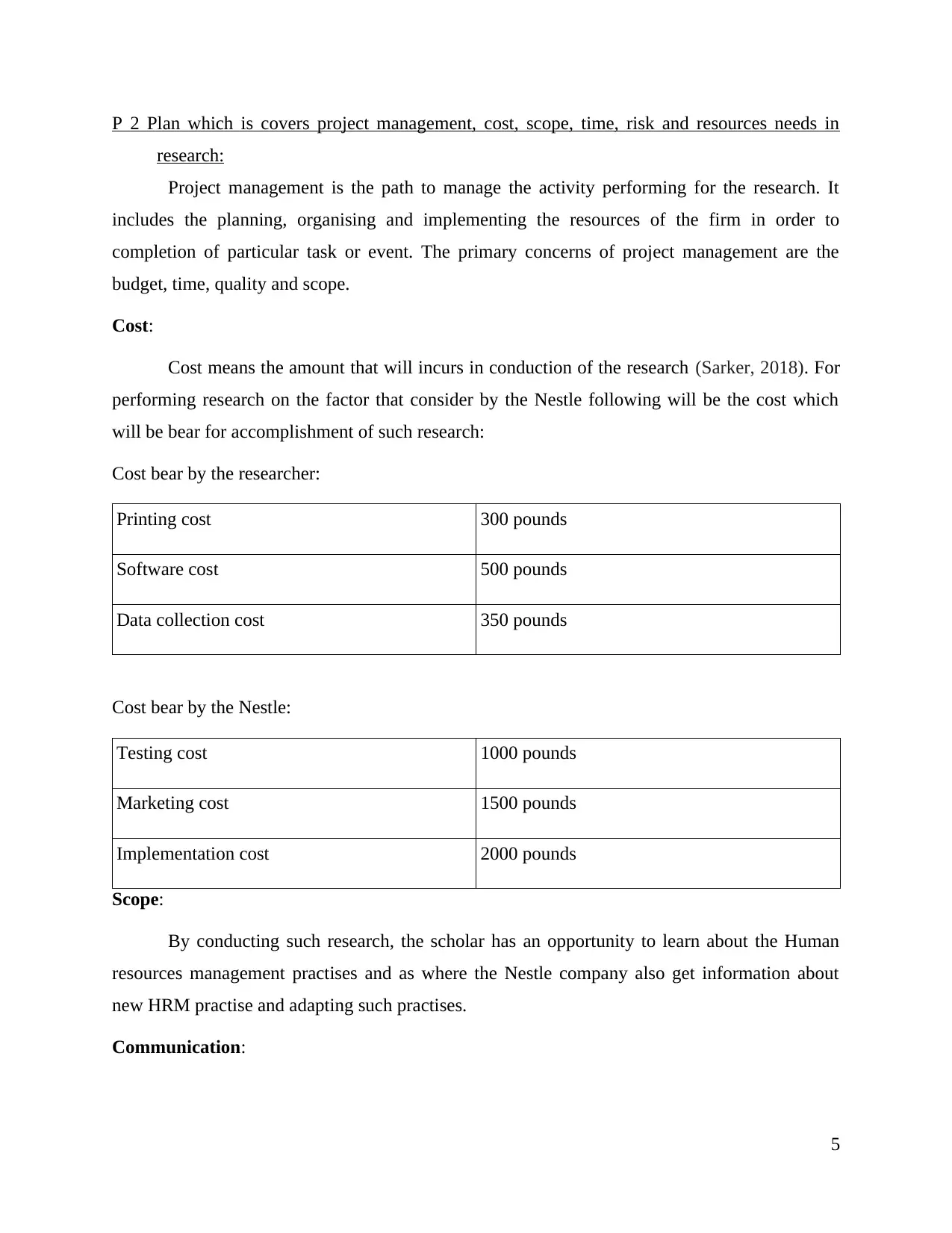
P 2 Plan which is covers project management, cost, scope, time, risk and resources needs in
research:
Project management is the path to manage the activity performing for the research. It
includes the planning, organising and implementing the resources of the firm in order to
completion of particular task or event. The primary concerns of project management are the
budget, time, quality and scope.
Cost:
Cost means the amount that will incurs in conduction of the research (Sarker, 2018). For
performing research on the factor that consider by the Nestle following will be the cost which
will be bear for accomplishment of such research:
Cost bear by the researcher:
Printing cost 300 pounds
Software cost 500 pounds
Data collection cost 350 pounds
Cost bear by the Nestle:
Testing cost 1000 pounds
Marketing cost 1500 pounds
Implementation cost 2000 pounds
Scope:
By conducting such research, the scholar has an opportunity to learn about the Human
resources management practises and as where the Nestle company also get information about
new HRM practise and adapting such practises.
Communication:
5
research:
Project management is the path to manage the activity performing for the research. It
includes the planning, organising and implementing the resources of the firm in order to
completion of particular task or event. The primary concerns of project management are the
budget, time, quality and scope.
Cost:
Cost means the amount that will incurs in conduction of the research (Sarker, 2018). For
performing research on the factor that consider by the Nestle following will be the cost which
will be bear for accomplishment of such research:
Cost bear by the researcher:
Printing cost 300 pounds
Software cost 500 pounds
Data collection cost 350 pounds
Cost bear by the Nestle:
Testing cost 1000 pounds
Marketing cost 1500 pounds
Implementation cost 2000 pounds
Scope:
By conducting such research, the scholar has an opportunity to learn about the Human
resources management practises and as where the Nestle company also get information about
new HRM practise and adapting such practises.
Communication:
5
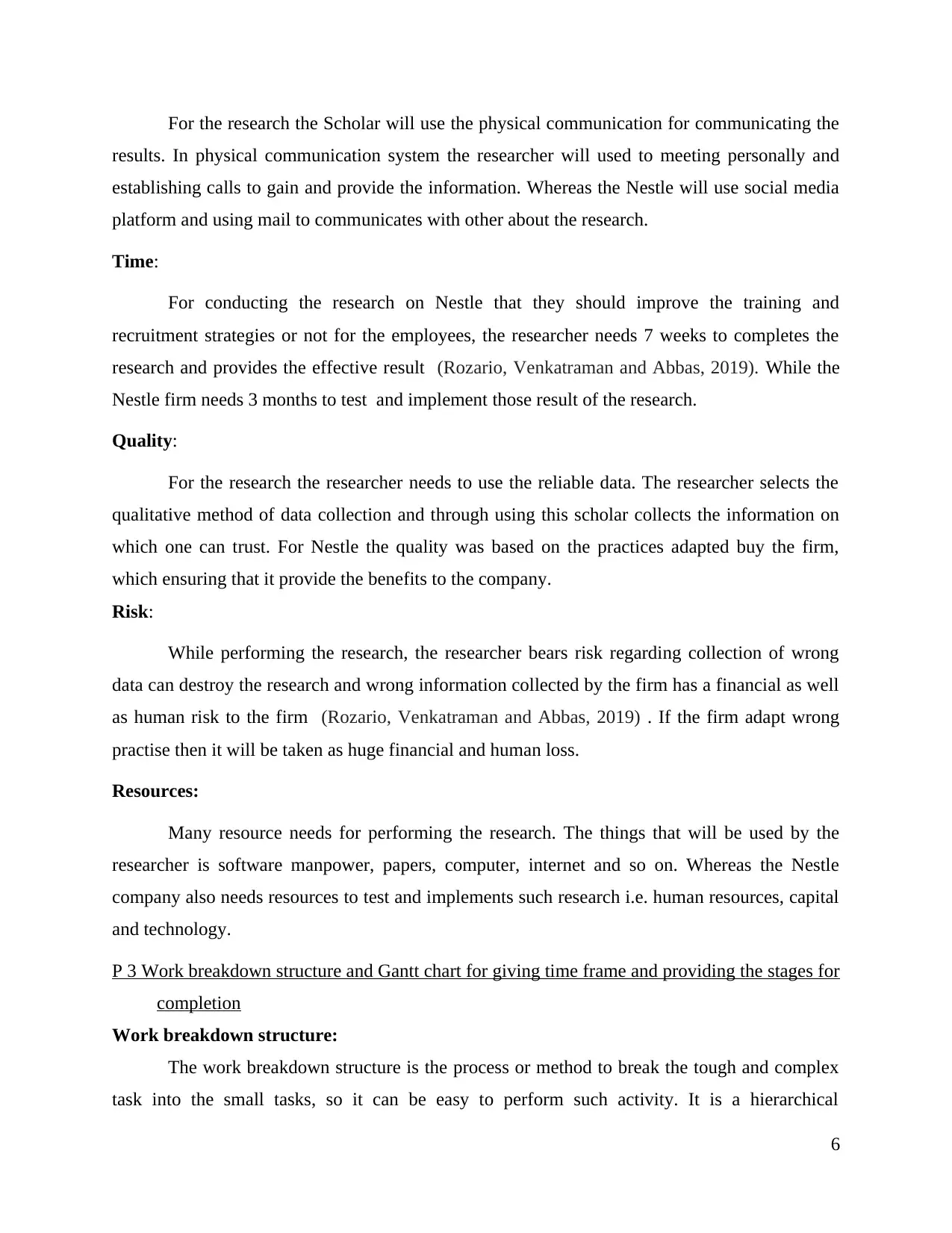
For the research the Scholar will use the physical communication for communicating the
results. In physical communication system the researcher will used to meeting personally and
establishing calls to gain and provide the information. Whereas the Nestle will use social media
platform and using mail to communicates with other about the research.
Time:
For conducting the research on Nestle that they should improve the training and
recruitment strategies or not for the employees, the researcher needs 7 weeks to completes the
research and provides the effective result (Rozario, Venkatraman and Abbas, 2019). While the
Nestle firm needs 3 months to test and implement those result of the research.
Quality:
For the research the researcher needs to use the reliable data. The researcher selects the
qualitative method of data collection and through using this scholar collects the information on
which one can trust. For Nestle the quality was based on the practices adapted buy the firm,
which ensuring that it provide the benefits to the company.
Risk:
While performing the research, the researcher bears risk regarding collection of wrong
data can destroy the research and wrong information collected by the firm has a financial as well
as human risk to the firm (Rozario, Venkatraman and Abbas, 2019) . If the firm adapt wrong
practise then it will be taken as huge financial and human loss.
Resources:
Many resource needs for performing the research. The things that will be used by the
researcher is software manpower, papers, computer, internet and so on. Whereas the Nestle
company also needs resources to test and implements such research i.e. human resources, capital
and technology.
P 3 Work breakdown structure and Gantt chart for giving time frame and providing the stages for
completion
Work breakdown structure:
The work breakdown structure is the process or method to break the tough and complex
task into the small tasks, so it can be easy to perform such activity. It is a hierarchical
6
results. In physical communication system the researcher will used to meeting personally and
establishing calls to gain and provide the information. Whereas the Nestle will use social media
platform and using mail to communicates with other about the research.
Time:
For conducting the research on Nestle that they should improve the training and
recruitment strategies or not for the employees, the researcher needs 7 weeks to completes the
research and provides the effective result (Rozario, Venkatraman and Abbas, 2019). While the
Nestle firm needs 3 months to test and implement those result of the research.
Quality:
For the research the researcher needs to use the reliable data. The researcher selects the
qualitative method of data collection and through using this scholar collects the information on
which one can trust. For Nestle the quality was based on the practices adapted buy the firm,
which ensuring that it provide the benefits to the company.
Risk:
While performing the research, the researcher bears risk regarding collection of wrong
data can destroy the research and wrong information collected by the firm has a financial as well
as human risk to the firm (Rozario, Venkatraman and Abbas, 2019) . If the firm adapt wrong
practise then it will be taken as huge financial and human loss.
Resources:
Many resource needs for performing the research. The things that will be used by the
researcher is software manpower, papers, computer, internet and so on. Whereas the Nestle
company also needs resources to test and implements such research i.e. human resources, capital
and technology.
P 3 Work breakdown structure and Gantt chart for giving time frame and providing the stages for
completion
Work breakdown structure:
The work breakdown structure is the process or method to break the tough and complex
task into the small tasks, so it can be easy to perform such activity. It is a hierarchical
6
⊘ This is a preview!⊘
Do you want full access?
Subscribe today to unlock all pages.

Trusted by 1+ million students worldwide
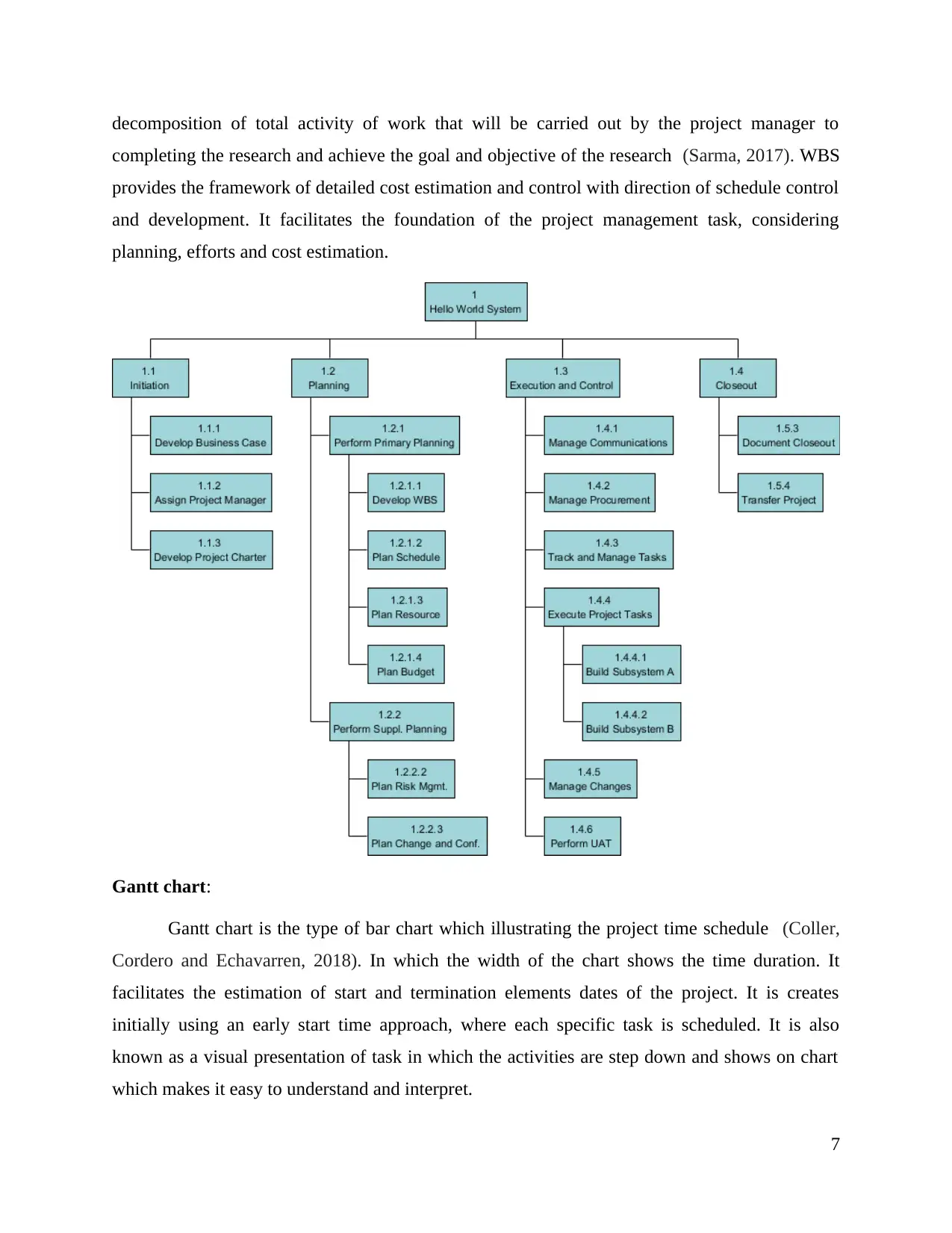
decomposition of total activity of work that will be carried out by the project manager to
completing the research and achieve the goal and objective of the research (Sarma, 2017). WBS
provides the framework of detailed cost estimation and control with direction of schedule control
and development. It facilitates the foundation of the project management task, considering
planning, efforts and cost estimation.
Gantt chart:
Gantt chart is the type of bar chart which illustrating the project time schedule (Coller,
Cordero and Echavarren, 2018). In which the width of the chart shows the time duration. It
facilitates the estimation of start and termination elements dates of the project. It is creates
initially using an early start time approach, where each specific task is scheduled. It is also
known as a visual presentation of task in which the activities are step down and shows on chart
which makes it easy to understand and interpret.
7
completing the research and achieve the goal and objective of the research (Sarma, 2017). WBS
provides the framework of detailed cost estimation and control with direction of schedule control
and development. It facilitates the foundation of the project management task, considering
planning, efforts and cost estimation.
Gantt chart:
Gantt chart is the type of bar chart which illustrating the project time schedule (Coller,
Cordero and Echavarren, 2018). In which the width of the chart shows the time duration. It
facilitates the estimation of start and termination elements dates of the project. It is creates
initially using an early start time approach, where each specific task is scheduled. It is also
known as a visual presentation of task in which the activities are step down and shows on chart
which makes it easy to understand and interpret.
7
Paraphrase This Document
Need a fresh take? Get an instant paraphrase of this document with our AI Paraphraser
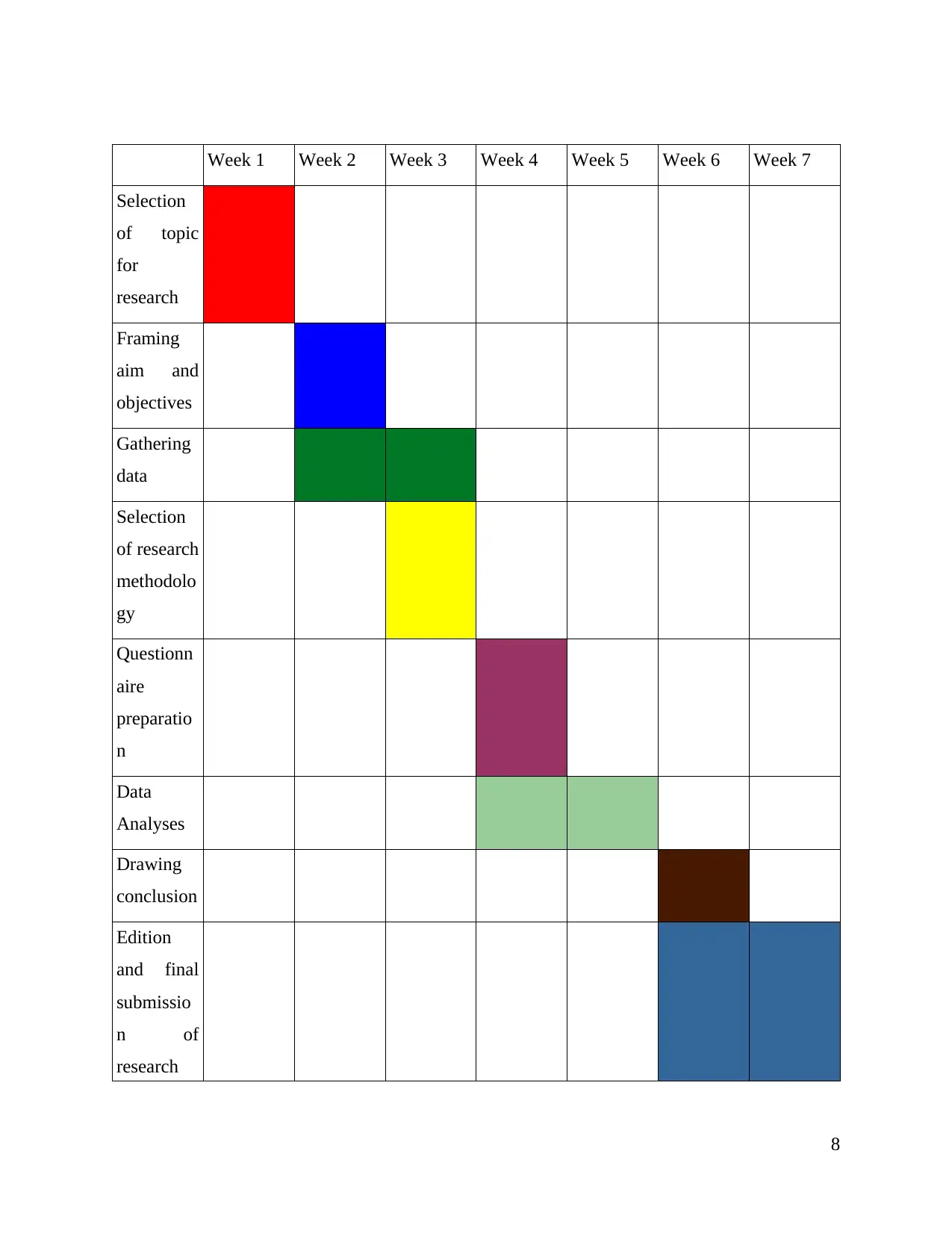
Week 1 Week 2 Week 3 Week 4 Week 5 Week 6 Week 7
Selection
of topic
for
research
Framing
aim and
objectives
Gathering
data
Selection
of research
methodolo
gy
Questionn
aire
preparatio
n
Data
Analyses
Drawing
conclusion
Edition
and final
submissio
n of
research
8
Selection
of topic
for
research
Framing
aim and
objectives
Gathering
data
Selection
of research
methodolo
gy
Questionn
aire
preparatio
n
Data
Analyses
Drawing
conclusion
Edition
and final
submissio
n of
research
8
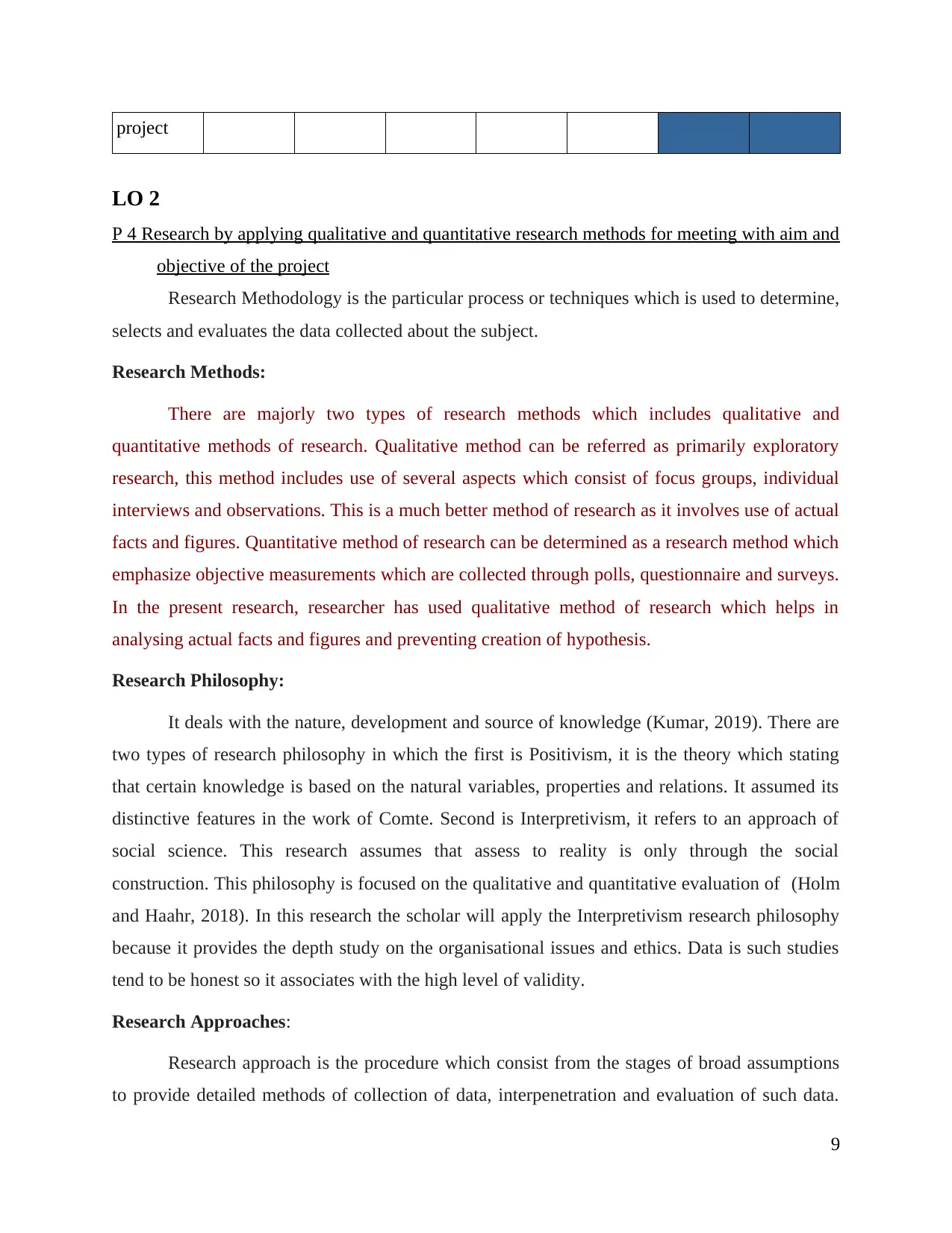
project
LO 2
P 4 Research by applying qualitative and quantitative research methods for meeting with aim and
objective of the project
Research Methodology is the particular process or techniques which is used to determine,
selects and evaluates the data collected about the subject.
Research Methods:
There are majorly two types of research methods which includes qualitative and
quantitative methods of research. Qualitative method can be referred as primarily exploratory
research, this method includes use of several aspects which consist of focus groups, individual
interviews and observations. This is a much better method of research as it involves use of actual
facts and figures. Quantitative method of research can be determined as a research method which
emphasize objective measurements which are collected through polls, questionnaire and surveys.
In the present research, researcher has used qualitative method of research which helps in
analysing actual facts and figures and preventing creation of hypothesis.
Research Philosophy:
It deals with the nature, development and source of knowledge (Kumar, 2019). There are
two types of research philosophy in which the first is Positivism, it is the theory which stating
that certain knowledge is based on the natural variables, properties and relations. It assumed its
distinctive features in the work of Comte. Second is Interpretivism, it refers to an approach of
social science. This research assumes that assess to reality is only through the social
construction. This philosophy is focused on the qualitative and quantitative evaluation of (Holm
and Haahr, 2018). In this research the scholar will apply the Interpretivism research philosophy
because it provides the depth study on the organisational issues and ethics. Data is such studies
tend to be honest so it associates with the high level of validity.
Research Approaches:
Research approach is the procedure which consist from the stages of broad assumptions
to provide detailed methods of collection of data, interpenetration and evaluation of such data.
9
LO 2
P 4 Research by applying qualitative and quantitative research methods for meeting with aim and
objective of the project
Research Methodology is the particular process or techniques which is used to determine,
selects and evaluates the data collected about the subject.
Research Methods:
There are majorly two types of research methods which includes qualitative and
quantitative methods of research. Qualitative method can be referred as primarily exploratory
research, this method includes use of several aspects which consist of focus groups, individual
interviews and observations. This is a much better method of research as it involves use of actual
facts and figures. Quantitative method of research can be determined as a research method which
emphasize objective measurements which are collected through polls, questionnaire and surveys.
In the present research, researcher has used qualitative method of research which helps in
analysing actual facts and figures and preventing creation of hypothesis.
Research Philosophy:
It deals with the nature, development and source of knowledge (Kumar, 2019). There are
two types of research philosophy in which the first is Positivism, it is the theory which stating
that certain knowledge is based on the natural variables, properties and relations. It assumed its
distinctive features in the work of Comte. Second is Interpretivism, it refers to an approach of
social science. This research assumes that assess to reality is only through the social
construction. This philosophy is focused on the qualitative and quantitative evaluation of (Holm
and Haahr, 2018). In this research the scholar will apply the Interpretivism research philosophy
because it provides the depth study on the organisational issues and ethics. Data is such studies
tend to be honest so it associates with the high level of validity.
Research Approaches:
Research approach is the procedure which consist from the stages of broad assumptions
to provide detailed methods of collection of data, interpenetration and evaluation of such data.
9
⊘ This is a preview!⊘
Do you want full access?
Subscribe today to unlock all pages.

Trusted by 1+ million students worldwide
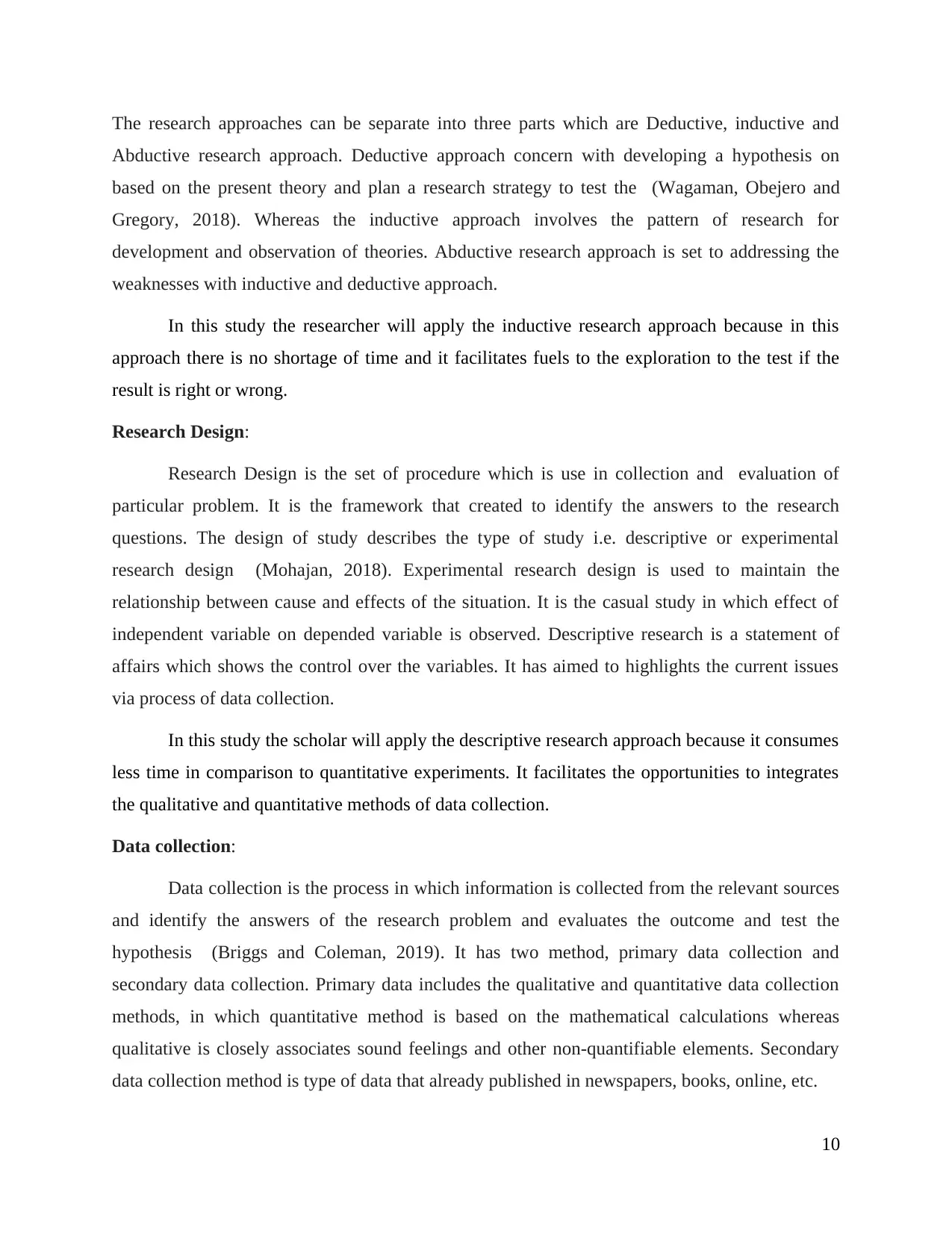
The research approaches can be separate into three parts which are Deductive, inductive and
Abductive research approach. Deductive approach concern with developing a hypothesis on
based on the present theory and plan a research strategy to test the (Wagaman, Obejero and
Gregory, 2018). Whereas the inductive approach involves the pattern of research for
development and observation of theories. Abductive research approach is set to addressing the
weaknesses with inductive and deductive approach.
In this study the researcher will apply the inductive research approach because in this
approach there is no shortage of time and it facilitates fuels to the exploration to the test if the
result is right or wrong.
Research Design:
Research Design is the set of procedure which is use in collection and evaluation of
particular problem. It is the framework that created to identify the answers to the research
questions. The design of study describes the type of study i.e. descriptive or experimental
research design (Mohajan, 2018). Experimental research design is used to maintain the
relationship between cause and effects of the situation. It is the casual study in which effect of
independent variable on depended variable is observed. Descriptive research is a statement of
affairs which shows the control over the variables. It has aimed to highlights the current issues
via process of data collection.
In this study the scholar will apply the descriptive research approach because it consumes
less time in comparison to quantitative experiments. It facilitates the opportunities to integrates
the qualitative and quantitative methods of data collection.
Data collection:
Data collection is the process in which information is collected from the relevant sources
and identify the answers of the research problem and evaluates the outcome and test the
hypothesis (Briggs and Coleman, 2019). It has two method, primary data collection and
secondary data collection. Primary data includes the qualitative and quantitative data collection
methods, in which quantitative method is based on the mathematical calculations whereas
qualitative is closely associates sound feelings and other non-quantifiable elements. Secondary
data collection method is type of data that already published in newspapers, books, online, etc.
10
Abductive research approach. Deductive approach concern with developing a hypothesis on
based on the present theory and plan a research strategy to test the (Wagaman, Obejero and
Gregory, 2018). Whereas the inductive approach involves the pattern of research for
development and observation of theories. Abductive research approach is set to addressing the
weaknesses with inductive and deductive approach.
In this study the researcher will apply the inductive research approach because in this
approach there is no shortage of time and it facilitates fuels to the exploration to the test if the
result is right or wrong.
Research Design:
Research Design is the set of procedure which is use in collection and evaluation of
particular problem. It is the framework that created to identify the answers to the research
questions. The design of study describes the type of study i.e. descriptive or experimental
research design (Mohajan, 2018). Experimental research design is used to maintain the
relationship between cause and effects of the situation. It is the casual study in which effect of
independent variable on depended variable is observed. Descriptive research is a statement of
affairs which shows the control over the variables. It has aimed to highlights the current issues
via process of data collection.
In this study the scholar will apply the descriptive research approach because it consumes
less time in comparison to quantitative experiments. It facilitates the opportunities to integrates
the qualitative and quantitative methods of data collection.
Data collection:
Data collection is the process in which information is collected from the relevant sources
and identify the answers of the research problem and evaluates the outcome and test the
hypothesis (Briggs and Coleman, 2019). It has two method, primary data collection and
secondary data collection. Primary data includes the qualitative and quantitative data collection
methods, in which quantitative method is based on the mathematical calculations whereas
qualitative is closely associates sound feelings and other non-quantifiable elements. Secondary
data collection method is type of data that already published in newspapers, books, online, etc.
10
Paraphrase This Document
Need a fresh take? Get an instant paraphrase of this document with our AI Paraphraser
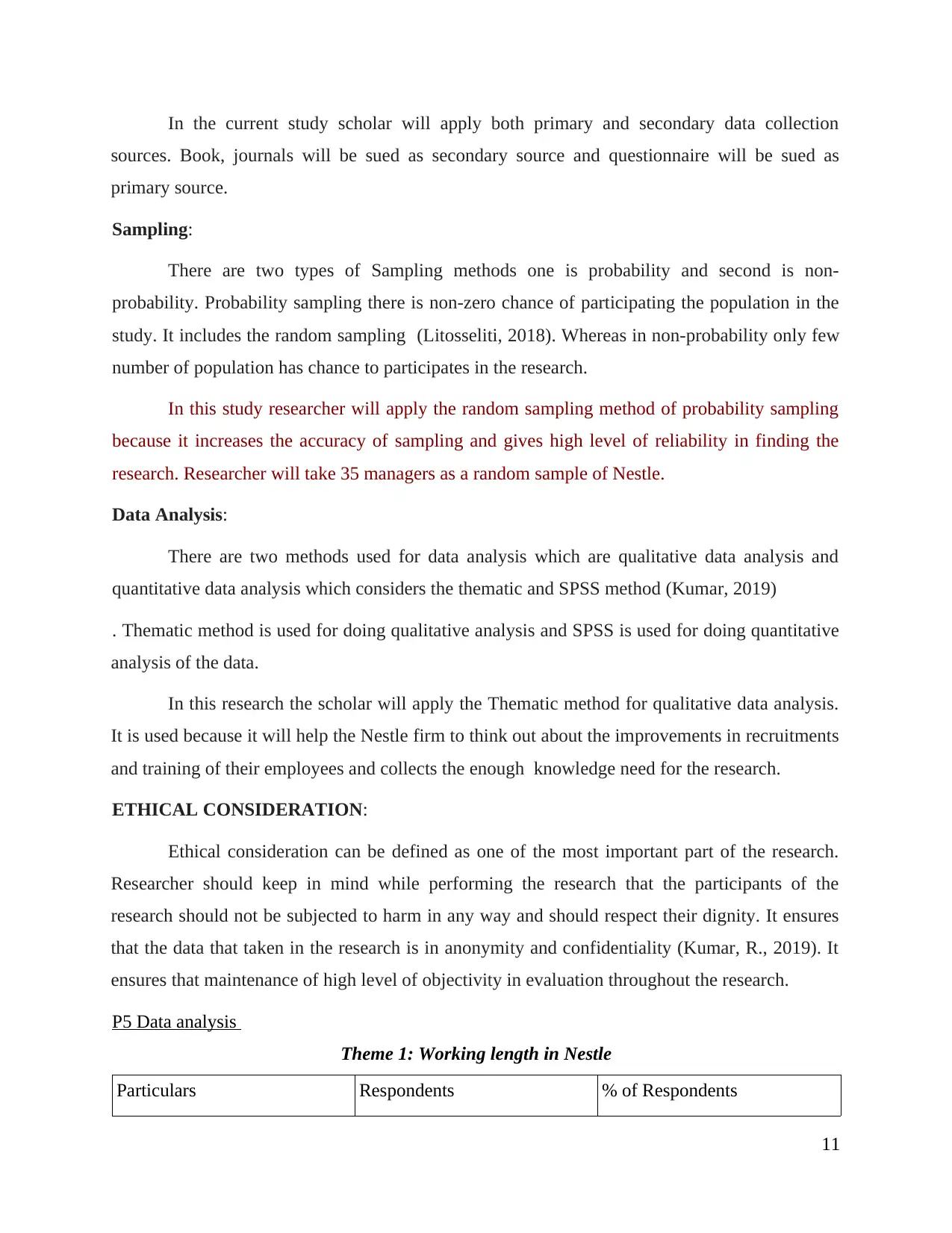
In the current study scholar will apply both primary and secondary data collection
sources. Book, journals will be sued as secondary source and questionnaire will be sued as
primary source.
Sampling:
There are two types of Sampling methods one is probability and second is non-
probability. Probability sampling there is non-zero chance of participating the population in the
study. It includes the random sampling (Litosseliti, 2018). Whereas in non-probability only few
number of population has chance to participates in the research.
In this study researcher will apply the random sampling method of probability sampling
because it increases the accuracy of sampling and gives high level of reliability in finding the
research. Researcher will take 35 managers as a random sample of Nestle.
Data Analysis:
There are two methods used for data analysis which are qualitative data analysis and
quantitative data analysis which considers the thematic and SPSS method (Kumar, 2019)
. Thematic method is used for doing qualitative analysis and SPSS is used for doing quantitative
analysis of the data.
In this research the scholar will apply the Thematic method for qualitative data analysis.
It is used because it will help the Nestle firm to think out about the improvements in recruitments
and training of their employees and collects the enough knowledge need for the research.
ETHICAL CONSIDERATION:
Ethical consideration can be defined as one of the most important part of the research.
Researcher should keep in mind while performing the research that the participants of the
research should not be subjected to harm in any way and should respect their dignity. It ensures
that the data that taken in the research is in anonymity and confidentiality (Kumar, R., 2019). It
ensures that maintenance of high level of objectivity in evaluation throughout the research.
P5 Data analysis
Theme 1: Working length in Nestle
Particulars Respondents % of Respondents
11
sources. Book, journals will be sued as secondary source and questionnaire will be sued as
primary source.
Sampling:
There are two types of Sampling methods one is probability and second is non-
probability. Probability sampling there is non-zero chance of participating the population in the
study. It includes the random sampling (Litosseliti, 2018). Whereas in non-probability only few
number of population has chance to participates in the research.
In this study researcher will apply the random sampling method of probability sampling
because it increases the accuracy of sampling and gives high level of reliability in finding the
research. Researcher will take 35 managers as a random sample of Nestle.
Data Analysis:
There are two methods used for data analysis which are qualitative data analysis and
quantitative data analysis which considers the thematic and SPSS method (Kumar, 2019)
. Thematic method is used for doing qualitative analysis and SPSS is used for doing quantitative
analysis of the data.
In this research the scholar will apply the Thematic method for qualitative data analysis.
It is used because it will help the Nestle firm to think out about the improvements in recruitments
and training of their employees and collects the enough knowledge need for the research.
ETHICAL CONSIDERATION:
Ethical consideration can be defined as one of the most important part of the research.
Researcher should keep in mind while performing the research that the participants of the
research should not be subjected to harm in any way and should respect their dignity. It ensures
that the data that taken in the research is in anonymity and confidentiality (Kumar, R., 2019). It
ensures that maintenance of high level of objectivity in evaluation throughout the research.
P5 Data analysis
Theme 1: Working length in Nestle
Particulars Respondents % of Respondents
11
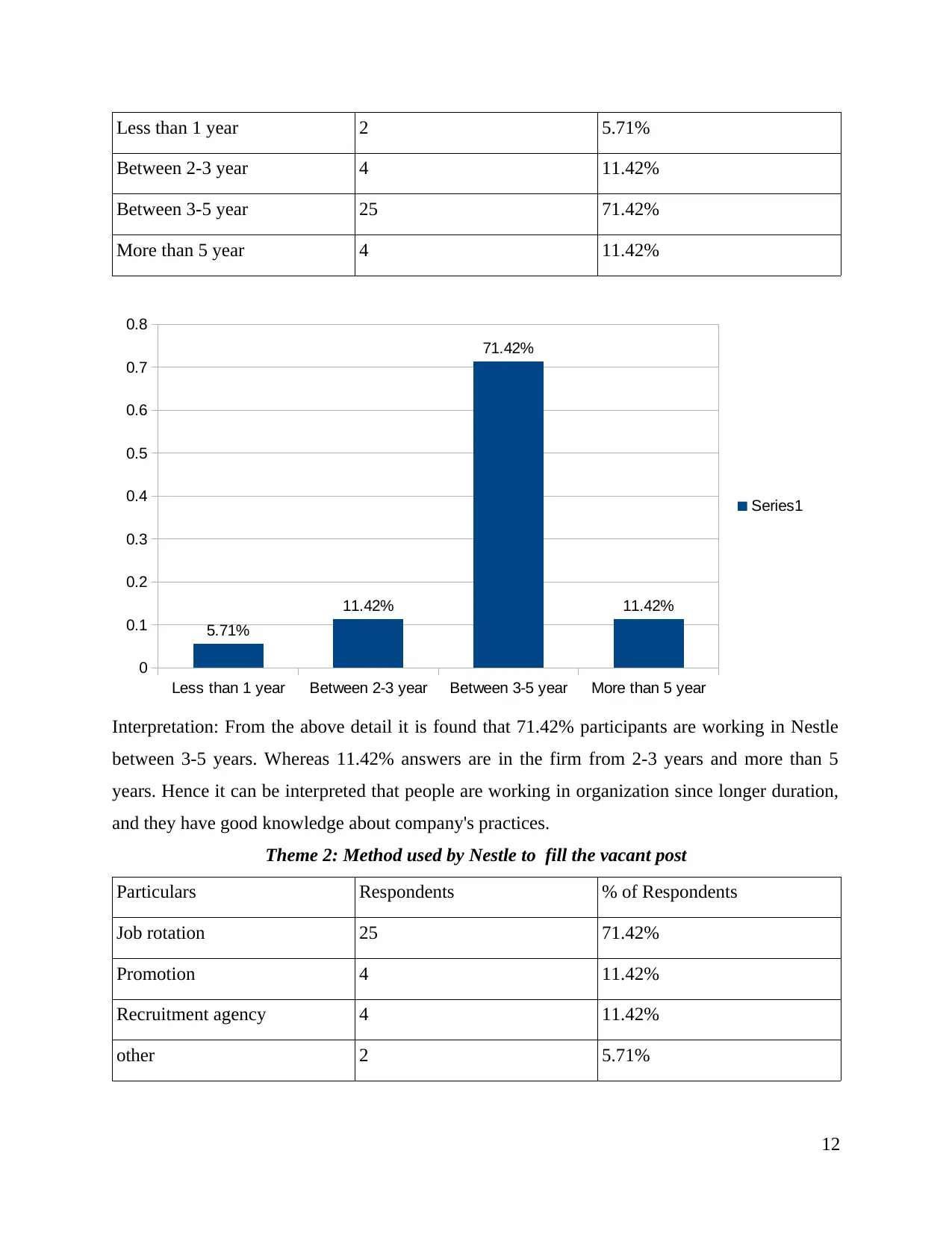
Less than 1 year 2 5.71%
Between 2-3 year 4 11.42%
Between 3-5 year 25 71.42%
More than 5 year 4 11.42%
Less than 1 year Between 2-3 year Between 3-5 year More than 5 year
0
0.1
0.2
0.3
0.4
0.5
0.6
0.7
0.8
5.71%
11.42%
71.42%
11.42%
Series1
Interpretation: From the above detail it is found that 71.42% participants are working in Nestle
between 3-5 years. Whereas 11.42% answers are in the firm from 2-3 years and more than 5
years. Hence it can be interpreted that people are working in organization since longer duration,
and they have good knowledge about company's practices.
Theme 2: Method used by Nestle to fill the vacant post
Particulars Respondents % of Respondents
Job rotation 25 71.42%
Promotion 4 11.42%
Recruitment agency 4 11.42%
other 2 5.71%
12
Between 2-3 year 4 11.42%
Between 3-5 year 25 71.42%
More than 5 year 4 11.42%
Less than 1 year Between 2-3 year Between 3-5 year More than 5 year
0
0.1
0.2
0.3
0.4
0.5
0.6
0.7
0.8
5.71%
11.42%
71.42%
11.42%
Series1
Interpretation: From the above detail it is found that 71.42% participants are working in Nestle
between 3-5 years. Whereas 11.42% answers are in the firm from 2-3 years and more than 5
years. Hence it can be interpreted that people are working in organization since longer duration,
and they have good knowledge about company's practices.
Theme 2: Method used by Nestle to fill the vacant post
Particulars Respondents % of Respondents
Job rotation 25 71.42%
Promotion 4 11.42%
Recruitment agency 4 11.42%
other 2 5.71%
12
⊘ This is a preview!⊘
Do you want full access?
Subscribe today to unlock all pages.

Trusted by 1+ million students worldwide
1 out of 35
Related Documents
Your All-in-One AI-Powered Toolkit for Academic Success.
+13062052269
info@desklib.com
Available 24*7 on WhatsApp / Email
![[object Object]](/_next/static/media/star-bottom.7253800d.svg)
Unlock your academic potential
Copyright © 2020–2025 A2Z Services. All Rights Reserved. Developed and managed by ZUCOL.



